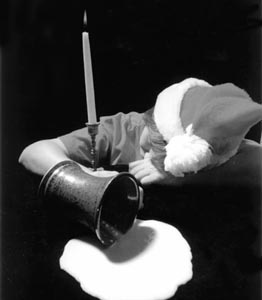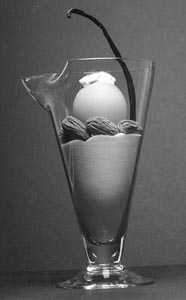![[MetroActive Dining]](/gifs/dining468.gif)
[ Dining Index | Sonoma County | MetroActive Central | Archives ]
Yolk Lore
Its ingredients can be lethal. But eggnog is still a favorite
By
ASK JONATHAN Panttaja how he came to be his family's designated eggnog maker, and he will give you a simple answer. "Um, I like eggnog," says Panttaja (pronounced pan-tay-ya; it's Finnish). "Unfortunately, there aren't a lot of eggnog fans in the family."
Most of his relatives, it turns out, are Tom & Jerry drinkers (gasp), a tradition firmly established on his father's side of the family, and indicative of that vast percentage of Americans who, while recognizing eggnog as the vital, historically entrenched holiday tradition that it is, can honestly not stomach the stuff.
"When I was 12 or 13," explains Panttaja, "I realized that if I wanted eggnog at the holidays, I would have to be the one who makes it."
Armed with a good, simple recipe--his mom, Mary Panttaja, helpfully adapted one from the Joy of Cooking cookbook--the recently married UC Santa Cruz grad student went on to perfect his nog-making skills over the course of numerous Thanksgiving dinners at his folks' home in Healdsburg. The result--an ultra-tasty, smooth-as-silk non-alcoholic confection, topped with a dusting of nutmeg, that is as sweet and rich as it is light and frothy--has since become a certified family tradition, running neck and neck, popularity-wise, against that other family favorite.
As to why eggnog--a weird mixture of eggs, cow juice, and sugar that really ought to taste like a runny, candied omelet--is as popular as it is . . . well, the jury's been out on that one for over 300 years.
Eggnog, in its earliest forms, can be traced back to the 17th century, though no one can agree on when it began to be called eggnog, or even why. While the "egg" part of "eggnog" is beyond argument, some claim that "nog"--an old English word for ale--was applied to the drink because of its warm, comforting nature (early eggnogs probably were made with ale and/or red Spanish wine). Others argue that "nog" was simply a shortened version of the slang word noggin, used to describe the short, heavy mugs that were used in drinking ale, beer--and something called "sack posset."
Originated in Staffordshire, England, sack posset was a hot wintry drink, popular in ale houses, that was made with egg, milk, and strong ale. It is similar to a European peasant drink called "syllabub" (made by squirting milk, fresh from the cow, into a pail of strong ale) and akin to the Italian zabaglione (a sweet egg-cream dessert flavored with Marsala wine and sometimes used as pastry filling), the German biersuppe (a beer-based eggnog, with currants and raisins thrown in for good measure), and the fabled English "egg flip" (hot eggs and cream, spiked with brandy).
At some point, the stuff became known as eggnog, perhaps around the time it arrived in America.
IN HIS EXHAUSTIVE tome The Dictionary of American Food and Drink, John F. Mariani reveals that the word eggnog did not show up in print until it appeared in an American broadside in the year 1775.
According to Mariani, the American colonists--in a fit of anti-English anarchism--had also taken to drinking their eggnog (or whatever) with rum and whisky, abandoning the ale or wine variations being consumed by the poor monarchists back home in England. Eventually, families developed their own, highly protected eggnog recipes, a tradition that still continues today, with some folks throwing annual eggnog parties
It was somewhere after the invention of the refrigerator, that eggnog evolved from the hot drink it had always been--it was the cooking that thickened the eggs, creating eggnog's trademark creamy texture--and became the sticky, gooey, artificially thickened, very cold substance we find today in grocery store cases; nothing like the hot, custardy, nourishing beverage that gently nudged our ancestors through their long wintry nights.
In fact, though eggnog is closely associated with holiday parties, historically it was often used medicinally, as a "restorative," a protein-rich dietary supplement for children and elderly folk. Ironically, the mighty eggnog--and face it, at 500 calories per serving (including the booze) it's a calorie-laden, cholesterol-drenched, dietary nightmare--was once considered a health drink.
Baseball great Joe DiMaggio swore by the stuff, praising its energy-giving qualities. Claiming that nothing worked better to put some power back in his swing, Joltin' Joe would often guzzle eggnog--laced with chocolate and sprinkled with nutmeg--in the Yankees dugout, to ward off batting slumps.
And did someone mention nutmeg?
Merry Christmas.
Nutmeg aside, the trickiest thing about eggnog, from a health department point of view, is the egg itself, since most family recipes, Panttaja's included, call for uncooked eggs. Notoriously susceptible to bacterial infestation, eggs should be cooked to definitively rid the things of salmonella and other bacterial bummers. Though many will claim that adding alcohol to eggnog will murder any uninvited microscopic party-poopers, medical experts say only cooking the egg, to 160 degrees, will render it safe for consumption.
Even so, according to the Centers for Disease Control in Atlanta, the chances of getting food poisoning from uncooked eggnog are only about 10,000 to 1.
Those seem like good odds to Panttaja, who says he's never gotten sick from eggnog, and worries that cooking would change its distinctive texture. "Ten thousand to one," he shrugs, "those are pretty good odds. Besides, this particular eggnog is so good,
"I'm willing to take my chances."
Jonathan Panttaja's Eggnog Recipe
NOTE: To those sufficiently spooked by egg-contamination worries, this recipe can be prepared safely by microwaving the eggs, after separation but before whipping, to a slow boil; it will alter the texture of the drink, but might make you feel better.
6 eggs, separated
Beat egg whites to a froth; set aside. Beat yolks with sugar until thick and creamy. Add vanilla, then stir in whites. Whip cream until very thick, and stir into mixture. The result will be too thick, so dilute with milk until it's liquid enough to drink. If desired, spike nog with liquor (about a shot per serving) of your choice. Garnish with nutmeg, if you dare. Makes 10 to 12 small servings.
Happy holidays!
[ Sonoma County | MetroActive Central | Archives ]
Copyright © Metro Publishing Inc. Maintained by Boulevards New Media.
![]()

to show off their nog-making skills.
 THOUGH IT'S unclear when nutmeg became so intimately connected to the eggnog tradition, it's even less clear why. Sure, a smattering of nutmeg tastes good, but the powdery spice is pure poison. Really. Originally grown in Indonesia, the oil of the nutmeg tree contains myristicin and elemicin, two dangerously powerful substances that, in sufficient quantities (one to three whole seeds, about half an ounce) will cause feelings of euphoria, flushed skin, a floating sensation, visual and auditory hallucinations, vomiting, complete circulatory collapse, and painful death.
THOUGH IT'S unclear when nutmeg became so intimately connected to the eggnog tradition, it's even less clear why. Sure, a smattering of nutmeg tastes good, but the powdery spice is pure poison. Really. Originally grown in Indonesia, the oil of the nutmeg tree contains myristicin and elemicin, two dangerously powerful substances that, in sufficient quantities (one to three whole seeds, about half an ounce) will cause feelings of euphoria, flushed skin, a floating sensation, visual and auditory hallucinations, vomiting, complete circulatory collapse, and painful death.
2 cups sugar
1 tbsp. vanilla
1 pint cream
Milk (as needed)
Nutmeg
From the December 9-15, 1999 issue of the Sonoma County Independent.